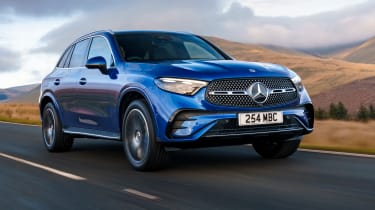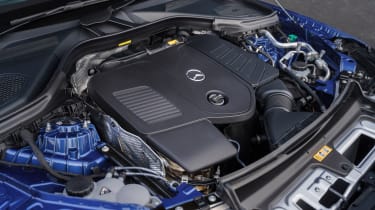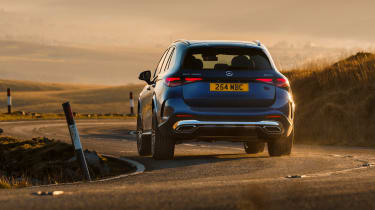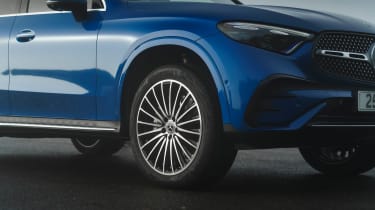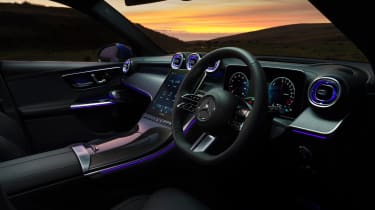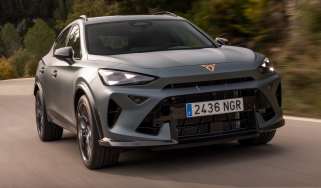Mercedes-Benz GLC 2025 review – still a worthy BMW X3 alternative?
The SUV segment is more competitive than ever, but Mercedes-Benz still offers something with its own unique appeal. Even if that appeal isn’t particularly evo
The mid-sized SUV is a genre evo isn’t typically fond of, with the increase in weight, size and ride height detracting from the driving dynamics of saloon and coupe counterparts. The Mercedes-Benz GLC represents one of the most polished of the ever-expanding bunch though, having been launched in 2015 as Stuttgart’s alternative to the long-standing BMW X3 and Audi Q5. As a result it’s become one of its very best-sellers, and an important part of the lineup.
The GLC range is a large one, now consisting of the entry-level 2-litre diesel GLC 220d, various hybrids and the range-topping 670bhp GLC 63 S E Performance – there’s even the middling GLC 43 with over 400bhp, making performance variants easy to find. We’ve spent time in a non-AMG plug-in hybrid model, and while its tech is certainly impressive, it’s not a car for the keen driver.
> BMW X3 M50 2025 review – 393bhp six-cylinder SUV previews the X3 M
Engine, gearbox and technical highlights
- Strong range of powertrains, including diesel
- Engine refinement lacking in plug-in hybrid
- Impressive c80-mile all-electric range in PHEV-form
The GLC we have on test (GLC 300 e 4Matic AMG Line Premium Plus, to give it its full name) sits at the top of the non-AMG lineup, pairing a 201bhp 2-litre four-cylinder with a 134bhp electric motor for a total of 309bhp. Given the hybrid assist torque is chunky at 406lb ft, driven to all four wheels through a nine-speed automatic transmission for a brisk 6.7sec 0-62mph time.
More reviews
Power delivery is as smooth and effortless as you’d expect from a premium Mercedes-Benz at low to moderate speeds, largely thanks to that electric torque fill – when the engine kicks on, it gains a noticeable boost in additional response too. Unfortunately the engine also introduces noise to the equation, and it’s not a nice one. Leave the car in its standard modes and it will hold revs unusually high even under normal urban driving, disrupting any sense of luxury – the engine sounds thrashy and not quite up to the task should you apply throttle at pace, feeling somewhat of an afterthought. For the £74,470 you’ll pay for this model (just shy of £80k for this exact car), a silky smooth six-cylinder would feel much more appropriate.
Thankfully you don’t need the engine for forward motion in this model as it’s equipped with a sizable 25.28kWh battery pack, capable of delivering up to 78 miles WLTP of all-electric running on a charge (which can be accepted at up to 60kw). In EV mode it’s supremely refined, with road and cabin noise very impressive at low speeds – creaks and rattles are hard to come by. The battery is also said to enable combined economy of up to 470mpg in combination with the engine, but in reality this figure is far lower – on a mixed urban and motorway 100-mile run with the battery depleted, we saw just under 35mpg on average. Given the fuel tank is a measly 49 litres, this isn’t so useful if you ever forget to charge the battery.
As with most plug-in hybrids there are a multitude of modes, and they’re not particularly intuitive here. The car starts in EV mode each and every time, so if you’d like to save battery power you’ll need to dive into the menus to change drive modes each time you set off. Once you’re on the move it’s tricky to find the mode best suited to long journeys too, with most keen to drop into EV mode and rinse the battery of its charge when you need it most.
If a plug-in hybrid isn't for you, there are plenty of alternatives in the GLC range. The entry-point gets you a mild-hybrid diesel for £54,450, with an entry-point mild-hybrid petrol costing just £2000 more. Each and every model in the UK lineup is all-wheel drive, with the 'e' designating plug-in hybrid in both petrol and diesel models. At the top of the range you'll find the mild-hybrid GLC 43 (£76,715) with over 420bhp, and the £123,185 GLC 63 S e Performance, fitted with that divisive 670bhp plug-in hybrid four-cylinder powertrain from the C63.
Model |
Power |
Torque |
0-62mph |
Top speed |
| GLC 300 4MATIC AMG Line | 277bhp | 295lb ft | 6.2sec | £56,495 |
| GLC 300 e 4MATIC AMG Line | 309bhp | 406lb ft | 6.7sec | £64,470 |
| GLC 63 S e Performance | 671bhp | 752lb ft | 3.5sec | £125,185 |
Driver’s note
‘The GLC feels like a premium product from the moment you step inside, with impressive tech, comfortable seats and attention to detail that others don’t quite manage. Sadly it feels as if the budget stops there, with the powertrain lacking in the refinement you’d expect from a car at such a price point.’ - Sam Jenkins, Senior Staff Writer, who drove the car on the road in the UK.
Performance, ride and handling
- Brakes are strong, if hard to modulate
- Secondary ride better than some rivals
- Wind noise spoils refinement at speed
The GLC is excellent in town but increase the pace and things aren’t quite as positive. Wind noise picks up at motorway speeds to spoil the quiet, and while secondary ride is improved thanks to chunky 45 and 40-profile front and rear tyres, more significant bumps make their way into the cabin and right through the seat – wide 285-section rear tyres also add a noticeable amount of tyre noise to the equation at speed.
At 2325kg it should come as no surprise that the PHEV GLC can struggle to manage its mass on a tricky road, and unlike some alternatives that opt for a stiff ride to compensate, the GLC’s spring rates remain low for a soft, wallowy ride (primarily thanks to the fitment of optional air suspension on this car). There’s a heavy dose of body roll that can be a little disconcerting initially, but understand the limits and there is plenty of grip to be found as a result.
Our test car was equipped with the £2495 'Refinement Package' which adds air suspension and rear axle steering (up to 4.5 degrees) which provide real-world benefits. That rear-wheel steering is great to have if you frequently find yourself in tight car parks, with the turning circle freakishly small for a car this size. Steering is undoubtedly light in every one of its modes, but it’s reasonably direct and inspires good confidence should you increase the pace.
Driver’s note
‘You won’t find yourself pushing the limits on a twisty b-road in this 2.3-tonne SUV, but ride is refreshingly cosseting for a premium SUV, where most rivals default to a firm, sporty setup. It’s far from perfect and there are scenarios that catch it off guard, but on the whole it meets its luxury brief well.’ - Sam Jenkins, Senior Staff Writer, who drove the car on the road in the UK.
Efficiency, charging and running costs
- Economy is good…until the the high voltage battery is empty
- c80 miles of pure electric running
- 49-litre fuel tank is frustratingly small
There are a total of 20 separate GLC variants to choose from on the configurator at the time of writing, but with each and every one either mild or plug-in hybrid, they’re all likely to offer strong economy in most circumstances. As in our test of the plug-in GLC 300 petrol, you won’t see much more than 35mpg should you drain the battery, but Mercedes-Benz claims up to 470mpg WLTP combined when it’s fully charged.
Elsewhere in the range, the entry-level mild-hybrid diesel is said to achieve 53.3mpg combined, the equivalent petrol 38.2mpg, and the most efficient of all, the plug-in hybrid diesel GLC 300 de at a bonkers 565mpg combined. AMG variants are predictably inefficient with the mild-hybrid GLC 43 at 27.2mpg and the plug-in hybrid GLC 63 sitting at 29.2mpg.
Interior and technology
- Chock full of tech
- Quality materials
- Menus can be frustrating
The cabin is where the GLC really excels, as while rivals have all introduced the likes of ambient lighting and large infotainment displays as standard, a well-optioned GLC goes far beyond this. With heat and noise isolating glass, a huge, augmented reality head-up display and niceties such as massage seats and a traffic light warning system, there’s not much more you could ask for. Its Digital Light headlights are a neat party piece, too, projecting pin sharp animations on the surface in front of the car on startup – they’ll even project warning signs onto the ground should you get a little too close to the leading car.
Aside from the tech, the cabin feels premium and worth the high price you’ll pay, with cold touch metal elements, tasteful open-pore wood trim and (admittedly faux) carbonfibre trim all contributing. The optional Burmester sound system is well calibrated too, which is not a given on premium cars in 2025, and the ambient lighting can be just as lairy and tacky as you’d like.
While there are some physical controls, the vast majority of these features are operated via the central 11.9-inch display, running the latest version of MBUX. The system looks slick (if a little like Windows Vista from 2007), but menu systems are overwhelming and it can be hard to access the many features the GLC can come equipped with. The driver also gets a large 12.3-inch digital dash for navigation, vital car information and entertainment previews.
Of course, not every GLC is made equally, with the base car coming without many of these features as standard, but even that comes with a digital driver’s display, ambient lighting, heated front seats, fingerprint biometric authentication and more at no cost.
Prices and buying options
Stack it up against the Audi A5 and the new BMW X3, and the Mercedes-Benz GLC is the most expensive of the three, starting at around £3000 more than its closest rivals with the £54,450 GLC 220d. It might be the most powerful of the three in its least expensive form, but it also happens to be the slowest, perhaps down to its 1985kg kerb weight (higher than both the BMW and Audi).
What the Mercedes-Benz GLC does offer is a vast range of powertrain options, with every one electrically assisted and a great choice of either petrol or diesel engines to suit every buyer. There’s also a range-topping performance model with almost 700bhp, and while it might not be the greatest of driver’s cars, neither BMW or Audi currently offer a suitable alternative.
You don’t need to opt for an AMG to have prices reach towards the six figure mark, with our GLC 300 e 4Matic AMG Line Premium Plus optioned to almost £80,000. The product line spans from entry-level AMG Line through to AMG Line Premium, Urban Edition, AMG Line Premium Plus and AMG Night Edition Premium Plus, with each step in the range bringing more standard kit and styling additions to the table. The latter is currently available only on the GLC 63 S e Performance at an eye watering cost of £125,185…
Model |
evo rating |
Price |
Kerb weight |
Power |
0-62mph |
| Mercedes-Benz GLC 220d | 3.5 | £54,450 | 1985kg | 217bhp | 8sec |
| BMW X3 20 | 3.5 | £51,605 | 1930kg | 205bhp | 7.8sec |
| Audi Q5 | 3 | £51,410 | 1895kg | 201bhp | 7.2sec |
